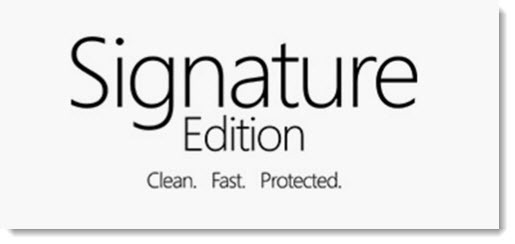Here’s a shopping tip if you’re looking for a new desktop or laptop PC: check the Microsoft Store for Signature Edition PCs.
Signature Edition PCs are shipped with Windows 10 – and nothing else. The drivers are installed that match the specific hardware but Signature Edition PCs don’t have any unnecessary programs at all. It is exactly the same experience that you would get if you took a new computer and immediately reformatted the hard drive and installed Windows from scratch (which is not a bad idea, by the way, if you have the technical skills to do it). Windows works like a dream. Nothing crashes. Systems sleep and wake up reliably and quickly. You’re less likely to have unfamiliar programs popping up when you click on a file for the first time. (That will be more true after you configure Windows 10 and fix its poorly chosen defaults.) Windows Defender provides security and antivirus protection.
A new computer is more likable when there is no crapware installed on it – the junk programs chosen by the manufacturers to make a few extra dollars by preinstalling unnecessary utilities, useless apps, terrible games, and advertising-laden trials of unwanted programs. At worst – and it is frequently at worst – the crapware slows down your new computer, causes it to start slowly, and makes your first couple of hours miserable as you deal with a blizzard of popups and license agreements. When you pay me to set up a new computer, much of my time is spent removing the crap.
When you have a poor experience with Windows, you blame Microsoft, but it’s actually the PC manufacturers who are responsible for this part of the bad experience. By itself, Windows 10 starts like lightning, returns from sleep instantly, and performs well on almost any combination of hardware. When your new computer starts slowly, freezes on web pages, and does not wake up instantly, the chances are that Windows is being prevented from doing its job by other programs.
Occasionally the preinstalled apps from the manufacturers are so poorly chosen that they turn into security risks. Lenovo was in the news last week when it disclosed that the “Lenovo Accelerator Application” installed on many of its desktops and laptops has a security flaw that makes it vulnerable to attackers. (Lenovo suggests uninstalling the app. Thinkpads are not affected, but many other models, including some Yogas, may have the app. Take a look and remove it if you find it.) Lenovo is not alone. A recent study literally could not find any OEM laptops that did not pose security risks because of poorly written bloatware.
When possible I buy Lenovo Thinkpads and computers from Dell’s Small Business division, which have much less preinstalled crud. Those tend to be more expensive – built for business with better parts and higher end components. If you’re looking for a less expensive, typical home or small business PC, there are literally thousands of choices from companies that make fine PCs – Dell, Lenovo, HP, Acer, Asus, and oh so many more. All of them have more or less crap on them when you take them out of the box.
Paul Thurrott recently assembled focus groups to compare the experience of starting up a Signature Edition PC with starting up the typical PC you’d buy online or at Best Buy. As you can imagine, almost everyone prefers to start up a clean PC without any crapware. A Signature Edition PC gets to its first desktop almost immediately, typically in half the time of a PC loaded with crud. Startup and shutdown times are noticeably shorter on Signature Edition PCs. The desktop and Start menu are comparatively uncluttered. (Comparatively. The Windows 10 Start menu is cluttered at best. Candy Crush Saga? Really, Microsoft? The point here is that it can be – and often is – worse.) The built-in antivirus protection, Windows Defender, is completely invisible, in stark contrast to the intrusive popups from the bundled antivirus programs included with almost every non-Signature Edition PC – some of which are trials that start badgering for money almost immediately.
Microsoft has a modest selection of laptops and desktop PCs but they’re chosen carefully and configured appropriately. In the laptops tonight, the Microsoft store has a Dell XPS 13 and Dell XPS 15, a single configuration of an HP Spectre x360, the Asus ZenBook Pro, an inexpensive Lenovo IdeaPad 500, some cheap Dell Inspirons, and of course Microsoft’s Surface Pro 4 and SurfaceBooks. For desktops, Microsoft is selling all-in-ones from Dell and Lenovo, a couple of versions of Dell’s powerful XPS 8900, and a few others ranging from an inexpensive Dell Inspiron to a variety of gaming PCs.
All of them have good specs and prices are similar to what you would pay if you ordered them directly from the OEMs. In some cases the Microsoft store has sales that allow you to pick up PCs for less than you would pay other places. In March, for example, a number of Dell computers were sold at very aggressive prices.
Even if the Signature Edition PCs cost more, though, this still might be a good shopping experience, for two reasons: (1) in this case it makes sense to pay more to get less – a better PC with less preinstalled crap, and (2) it’s comforting to have a curated shopping experience as an alternative to dealing with the overwhelming selection of thousands of models and configurations on the market. Dell and Lenovo each have something like sixty or seventy different models of laptops, with innumerable possible configurations. Microsoft reduces the selection to a manageable number of choices.
I can’t promise that you’ll find the computer of your dreams at the Microsoft store, but stop by when you’re shopping. You might find something that’s just right and get the benefits of an uncluttered experience with Signature Edition.



Trackbacks/Pingbacks